-
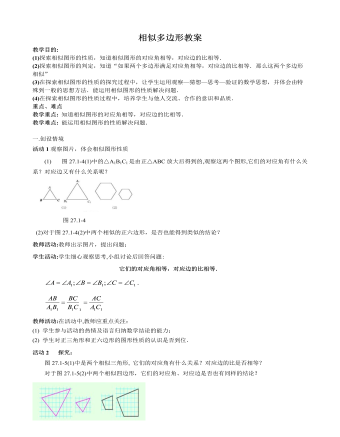
北师大初中数学九年级上册相似多边形2教案
(2)相似多边形的对应边的比称为相似比;(3)当相似比为1时,两个多边形全等.二、运用相似多边形的性质.活动3 例:如图27.1-6,四边形ABCD和EFGH相似,求角 的大小和EH的长度 .27.1-6教师活动:教师出示例题,提出问题;学生活动:学生通过例题运用相似多边形的性质,正确解答出角 的大小和EH的长度 .(2人板演)活动41.在比例尺为1﹕10 000 000的地图上,量得甲、乙两地的距离是30 cm,求两地的实际距离.2.如图所示的两个直角三角形相似吗?为什么?3.如图所示的两个五边形相似,求未知边 、 、 、 的长度.教师活动:在活动中,教师应重点关注:(1)学生参与活动的热情及语言归纳数学结论的能力;(2)学生对于相似多边形的性质的掌握情况.三、回顾与反思.(1)谈谈本节课你有哪些收获.(2)布置课外作业:教材P88页习题4.4
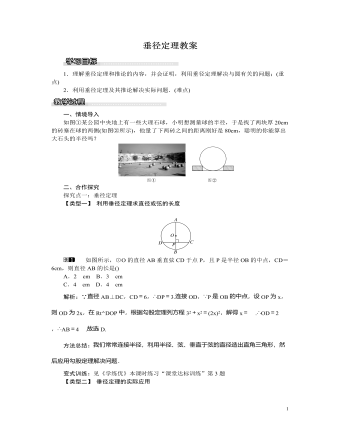
北师大初中九年级数学下册垂径定理教案
方法总结:垂径定理虽是圆的知识,但也不是孤立的,它常和三角形等知识综合来解决问题,我们一定要把知识融会贯通,在解决问题时才能得心应手.变式训练:见《学练优》本课时练习“课后巩固提升”第2题【类型三】 动点问题如图,⊙O的直径为10cm,弦AB=8cm,P是弦AB上的一个动点,求OP的长度范围.解析:当点P处于弦AB的端点时,OP最长,此时OP为半径的长;当OP⊥AB时,OP最短,利用垂径定理及勾股定理可求得此时OP的长.解:作直径MN⊥弦AB,交AB于点D,由垂径定理,得AD=DB=12AB=4cm.又∵⊙O的直径为10cm,连接OA,∴OA=5cm.在Rt△AOD中,由勾股定理,得OD=OA2-AD2=3cm.∵垂线段最短,半径最长,∴OP的长度范围是3cm≤OP≤5cm.方法总结:解题的关键是明确OP最长、最短时的情况,灵活利用垂径定理求解.容易出错的地方是不能确定最值时的情况.

北师大初中七年级数学下册用尺规作角教案
解析:①以O为圆心,任意长为半径作弧交OA于D,交OB于C;②以O′为圆心,以同样长(OC长)为半径作弧,交O′B′于C′;③以C′为圆心,CD长为半径作弧交前弧于D′;④过D′作射线O′A′,∠A′O′B′为所求.解:如下图所示.【类型三】 利用尺规作角的和或差已知∠AOB,用尺规作图法作∠A′O′B′,使∠A′O′B′=2∠AOB.解析:先作一个角等于∠AOB,再以这个角的一边为边在其外部作一个角等于∠AOB,那么图中最大的角就是所求的角.解:作法:①作∠DO′B′=∠AOB;②在∠DO′B′的外部作∠A′O′D=∠AOB,∠A′O′B′就是所求的角(如下图).三、板书设计1.尺规作图2.用尺规作角本节课学习了有关尺规作图的相关知识,课堂教学内容以学生动手操作为主,在学生动手操作的过程中要鼓励学生大胆动手,培养学生的动手能力和书面语言表达能力
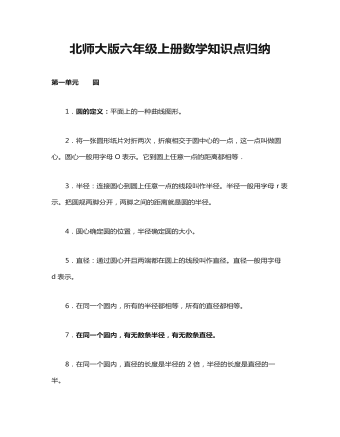
北师大版六年级上册数学知识点总结教案
第一单元 圆1.圆的定义:平面上的一种曲线图形。2.将一张圆形纸片对折两次,折痕相交于圆中心的一点,这一点叫做圆心。圆心一般用字母O表示。它到圆上任意一点的距离都相等.3.半径:连接圆心到圆上任意一点的线段叫作半径。半径一般用字母r表示。把圆规两脚分开,两脚之间的距离就是圆的半径。4.圆心确定圆的位置,半径确定圆的大小。5.直径:通过圆心并且两端都在圆上的线段叫作直径。直径一般用字母d表示。6.在同一个圆内,所有的半径都相等,所有的直径都相等。7.在同一个圆内,有无数条半径,有无数条直径。8.在同一个圆内,直径的长度是半径的2倍,半径的长度是直径的一半。用字母表示为:d=2r r =1/2d 用文字表示为:半径=直径÷2 直径=半径×2
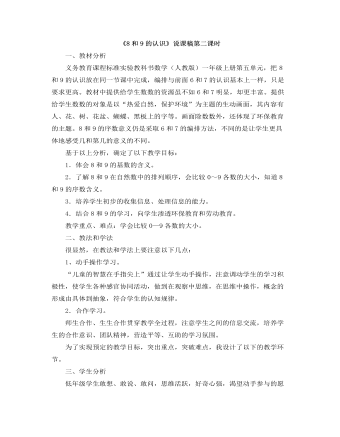
小学数学人教版一年级上册《8和9的认识》说课稿第二课时
一、教材分析义务教育课程标准实验教科书数学(人教版)一年级上册第五单元,把8和9的认识放在同一节课中完成,编排与前面6和7的认识基本上一样,只是要求更高。教材中提供给学生数数的资源虽不如6和7明显,却更丰富。提供给学生数数的对象是以“热爱自然,保护环境”为主题的生动画面,其内容有人、花、树、花盆、蝴蝶、黑板上的字等。画面除数数外,还体现了环保教育的主题。8和9的序数意义仍是采取6和7的编排方法,不同的是让学生更具体地感受几和第几的意义的不同。基于以上分析,确定了以下教学目标:1.体会8和9的基数的含义。 2.了解8和9在自然数中的排列顺序,会比较0~9各数的大小,知道8和9的序数含义。 3.培养学生初步的收集信息、处理信息的能力。 4.结合8和9的学习,向学生渗透环保教育和劳动教育。 教学重点、难点:学会比较0—9各数的大小。

小学数学人教版一年级上册《8和9的认识》说课稿第一课时
今天我说课的内容是义务教育课程标准实验教科书数学一年级上册第50、51页的教学内容《8和9的认识》。一、说教材教科书第50~51页上8、9的认识的编排与前面6、7的认识基本上一样,不过比认识6、7的要求稍微高一些。主要是可供学生数数的资源更丰富,并且所数事物的数量不像6、7那样明显。我把这节课的教学目标定为(1)在观察、操作、演示等活动中,感受8和9的意义,能用这两个数表示物体的个数或事物的顺序和位置,会比较它们的大小,建立8、9的数的概念。会读、写8和9。(2)培养学生的观察、操作、语言表达能力,培养学生初步的数学交流意识。(3)让学生感受数学源于生活,用于生活,激发学生学数学的兴趣,渗透进行环保教育。根据上述教学目标,我确立本节课的教学重点、难点是教学重点:能正确数出数量是8和9的物体的个数,会读写数字8和9。 教学难点:正确区别8、9的基数和序数的意义。
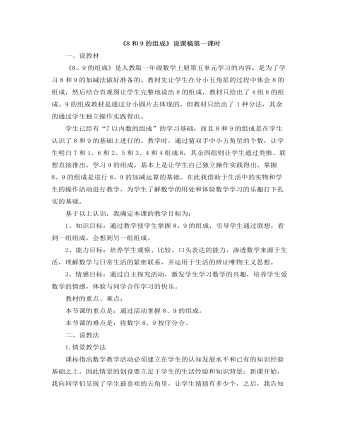
小学数学人教版一年级上册《8和9的组成》说课稿第一课时
一、说教材《8、9的组成》是人教版一年级数学上册第五单元学习的内容,是为了学习8和9的加减法做好准备的。教材先让学生在分小五角星的过程中体会8的组成,然后结合直观图让学生完整地说出8的组成,教材只给出了4组8的组成。9的组成教材是通过分小圆片去体现的,但教材只给出了1种分法,其余的通过学生独立操作实践得出。学生已经有“7以内数的组成”的学习基础,而且8和9的组成是在学生认识了8和9的基础上进行的。教学时,通过猜双手中小五角星的个数,让学生明白7和1、6和2、5和3、4和4组成8,其余四组则让学生通过类推、联想直接推出。学习9的组成,基本上是让学生自己独立操作实践得出。掌握8、9的组成是进行8、9的加减运算的基础。在此我借助于生活中的实物和学生的操作活动进行教学,为学生了解数学的用处和体验数学学习的乐趣打下扎实的基础。

小学数学人教版三年级上册《毫米和分米的认识》说课稿
一、教材分析本课是人教版3年级上册数学第3单元的第1课时,本课内容是在学习了长度单位米和厘米的基础上进行教学的,通过学习,使学生对常用的长度单位有一个比较完整的认识,对于今后学习面积单位和体积单位,发展学生的空间观念具有重要意义。二、教学目标:根据对教材的理解,同时结合学生已有的认知结构和心理特征,制定如下教学目标:(1)、知识目标:认识长度单位毫米和分米, 初步建立1毫米和1分米的长度观念;知道1分米=10厘米,1厘米=10毫米,1米=10分米,并能进行长度单位间的简单换算。(2)、能力目标:通过估一估、量一量等活动,培养和发展学生的空间观念、估测能力、动手操作能力和推理能力。(3)、情感目标:经历实际测量的过程,体会长度单位在日常生活中的应用,感受数学和生活的密切联系,体验数学学习的乐趣。
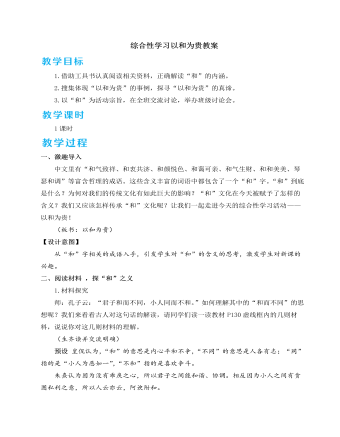
人教部编版语文八年级下册综合性学习以和为贵教案
请同学们阅读教材P133虚线框内的内容,根据要求选择某一新闻事件,开展时事讨论,积极发表看法。提示:学生围绕事件展开讨论,积极发言,认真听取同学的意见,讨论时注意遵守之前制定的“班级议事规则”。(全班讨论,师总结)【设计意图】此环节通过开展班级讨论活动,制定贴近学生生活的“班级议事规则”,将学习的与“和”相关的知识引入实践生活,培养学生运用知识指导生活实践的综合能力。五、以“和”为文,总结收获师:同学们,通过本次综合性学习活动,我们知道了“以和为贵”不仅是为人处世的准绳,也是从政治国的法宝,是处理国际关系的原则,是创建和谐社会的前提条件。通过这次活动,你对中国文化中的“和”一定也有了许多的认识和理解吧!任选一个角度,写一篇不少于600字的作文,谈谈你的收获。
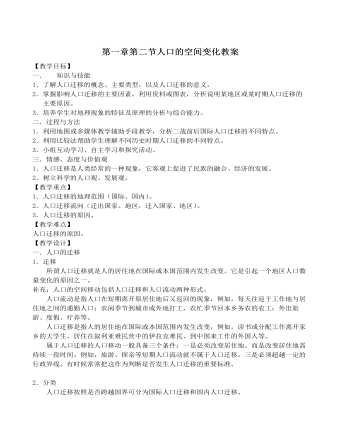
人教版新课标高中地理必修2第一章第二节人口的空间变化教案
1.促使美国成为一个移民国家的因素是:①美洲属于未开发的新大陆,需要大量的劳动力;②欧洲失业工人和破产农民增加,人们为了追求更好的经济待遇迁往美洲;③新航线的开辟为人们顺利迁移扫除了障碍;④殖民扩张是人口迁移的促进因素,加快了人口迁移的过程。导致美国人口在本土范围内频繁迁移的原因,归纳起来有:第一次人口迁移是战争因素,第二次是城市化;第三次是自然环境、经济环境的变化;第四次是经济格局的变化,即西部和南部新资源的发现和新兴工业的发展。2.我国古代的人口迁移,深受统治者及其行政力量的束缚。封建帝王为了加强本国的经济和军事实力,对人口迁移严加控制。只有当战乱发生的时候,这种控制才得到削弱,人们为了躲避战乱,寻找安定的生活环境,不得不进行大规模的迁移。我国近几十年的人口迁移主要是由生产资料和劳动力数量上的地区分布不平衡造成的,是经济因素在起主导作用,与古代的人口迁移截然不同。

人教版新课标高中地理必修2第三章第一节农业区位的选择教案
1.澳大利亚混合农业地域在生产结构、经营方式、科技应用、农业专业化和地域化等方面有哪些特点?2.在澳大利亚混合农业地 域形成的过程中,有哪些区位因素在起作用?学生发言,教师适当引导、评点并作讲解。[教师提问]:那么,澳大利亚的墨累—达令盆地的区位因素有什么不足之处?知识拓展:课件展示澳大利亚大分水岭的雨影效应的形成原理及东水西调示意图。[教师讲解]:澳大利亚东南部受大分水岭的影响,降水集中于大分水岭的东侧,在其西侧形成山地的雨影效应,降水丰富地区与农业生产地区分布不一致,灌溉成为澳大利亚农牧业发展的限制性条件。因此,澳大利亚对水利工程建设很 重视,东水西调促进了墨累—达令盆地农牧业的发展。[课堂小结]:这节课我们学习了农业区位选择的基本原理。 通过学习我们了解到,农业的区位选择实质上就是对农业土地的合理利用。

大班数学:新车出厂课件教案
活动准备:数字2、6、8、8四套、记录纸4张车牌号码 活动流程:一、交流城市新车感受城市变化,给生活带来得方便1、师:张老师买了辆新车,你们看!(出示别克凯悦)你还知道别克凯悦啊,那你还知道哪些车?2、新车拿到了,我要上路了,现在能出发了吗?(没有挂牌照)没有牌照会怎么样?排列汽车牌照 教师小结:牌照就象一辆车子的身份、名字,每辆车的车牌都不一样。上海一个牌照很贵呢!

大班数学活动:复习单数和双数课件教案
2、幼儿的动手、分辨能力,发展幼儿思维的灵活性。活动准备:几何图形挂件一人一个,数字卡片,演示教具,魔术卡每人一张活动过程:一、带幼儿进知识宫,激发幼儿的兴趣。师:今天老师要带小朋友到知识宫去玩。在知识宫,老师要给小朋友好多礼物,但这些礼物一定要小朋友动脑筋才能够得到。第一份礼物需根据自己挂着的图形和图形上的数字找座位,找到了,这个图形就作为第一份礼物送给你们。

人教版新课标高中物理必修1探究小车速度随时间变化的规律教案2篇
三、作出速度-时间图像(v-t图像)1、确定运动规律最好办法是作v-t图像,这样能更好地显现物体的运动规律。2、x y x1 x2 y2 y1 0讨论如何在本次实验中描点、连线。(以时间t为横轴,速度v为纵轴,建立坐标系,选择合适的标度,把刚才所填表格中的各点在速度-时间坐标系中描出。注意观察和思考你所描画的这些点的分布规律,你会发现这些点大致落在同一条直线上,所以不能用折线连接,而用一根直线连接,还要注意连线两侧的点数要大致相同。)3、若出现了个别明显偏离绝大部分点所在直线的点,该如何处理?(对于个别明显偏离绝大部分点所在直线的点,我们可以认为是测量误差过大、是测量中出现差错所致,将它视为无效点,但是在图像当中仍应该保留,因为我们要尊重实验事实,这毕竟是我们的第一手资料,是原始数据。)4、怎样根据所画的v-t图像求加速度?(从所画的图像中取两个点,找到它们的纵、横坐标(t1,v1)、(t2,v2),然后代入公式,求得加速度,也就是直线的斜率。在平面直角坐标系中,直线的斜率

人教版新课标高中物理必修1探究小车速度随时间变化的规律教案2篇
3、若出现了个别明显偏离绝大部分点所在直线的点,该如何处理?(对于个别明显偏离绝大部分点所在直线的点,我们可以认为是测量误差过大、是测量中出现差错所致,将它视为无效点,但是在图像当中仍应该保留,因为我们要尊重实验事实,这毕竟是我们的第一手资料,是原始数据。)4、怎样根据所画的v-t图像求加速度?(从所画的图像中取两个点,找到它们的纵、横坐标(t1,v1)、(t2,v2),然后代入公式,求得加速度,也就是直线的斜率。在平面直角坐标系中,直线的斜率四、实践与拓展例1、在探究小车速度随时间变化规律的实验中,得到一条记录小车运动情况的纸带,如图所示。图中A、B、C、D、E为相邻的计数点,相邻计数点的时间间隔为T=0.1s。⑴根据纸带上的数据,计算B、C、D各点的数据,填入表中。

人教版新目标初中英语八年级下册It’s a nice day, isn’t it教案2篇
"Hello! Welcome to English class! Introduce yourself. Meet your new classmates." That's what the teacher says. What do you say? "Oh no!" It can be difficult talking to new people. But it can be fun, and you can make friends. How do you do it? Make small talk. Small talk is polite conversation. "Wang Nan is a great pingpang player, isn't she?" "I'd love to meet her, wouldn't you?" "It's been raining a lot, hasn't it?" Tag questions are a form of polite speech. To make small talk successfully, you should know how to make them. You should also know what topics to talk about. Try to learn this unit carefully. The next time you're in English class, you'll find out. Making small talk's easy, isn't it? (“你好!欢迎你!请做一下自我介绍。认识一下你的新同学。”通常在课上老师会这样说。你会说什么呢?“噢,不!”与陌生人谈话太困难了。但是这也很有意思,并且你还能交到朋友。你该怎么做呢?闲聊。闲聊指得是礼貌的对话。“王楠是一个很棒的乒乓球运动员,不是吗?”“我希望自己能认识她,你呢?“今年的雨水很多,不是吗?”反意疑问句是一种礼貌用语。为了使得谈话成功,你应该知道怎样去进行闲聊。你还应该知道与不同的人该谈论什么样的话题。认真的学习这个单元吧,下次在英语课上,你会发现与大家展开谈话是一件很容易的事情,不信我们来试试。)

人教版新目标初中英语七年级下册How was your weekend教案2篇
Teaching Goal:1. General aims:Talk about recent past events2. Particular aims:A. Language Focus.Talk about recent past events and think of the past events.B. Language goalsHow was….?It was …What did …do over the weekend?C. Language structures:(1). How was your weekend? I was great. Pay attention to no form.(2). What did you do over the weekend? I played soccer. We went to the beach.D. Useful words and phrases:Words: was, did, went, beach, over, project, test, wasn’t, false, number, geography, spend, week, most, mixture, their, had, little, cook, read, saw, change, everyone, sit, sat, no, anythingPhrases: did one’s homework, played soccer, cleaned my room, went to the beach, played tennis, went to the movies, on Saturday morning, over the weekend, cook … for, what about, do some reading, have a party, talk show, go shoppingE. Grammar language:Present simple past tenseRegular and irregular verbsF. Learning strategies:Tour and holidaysG. Interdiscipinary:H. Emotion and manner:Teaching time: 5 periodsTeaching procedures:Period One教学步骤、时间 教师活动 学生活动 媒体应用Step 1Free talk 3’ Ask some questions like:Who’s on duty today?What’s the weather like? Answer and talk about something.让同学们回答下列问题1. Do you like weekend? (Let some students answer)It takes them three minutes to talk about the question.2. Why do you like weekend? (let the students answer) Most of the students like the weekend此时教师用汉语问:“在周末期间问你干了什么?这句话用英语这么回答?Let the students guess.At last the teacher give them right answer3. What did you do over the weekend?(板书、学习)

人教版新目标初中英语七年级下册Where is the post office教案2篇
Period 2 (3a----Section B 2c)Preview(Pre-task): Key points: What laAdd another information about their pen pals----their language on the cardnguage does she/he speak?She/He speaks....Does she/he have any brothers and sisters? Does she/he speak English?Preview(Pre-task): Add another information about their pen pals----their language on the cardKey points: What language does she/he speak?She/He speaks....Does she/he have any brothers and sisters? Does she/he speak English?Step 1 Revision1.Revisionand dictation of the new words 2.Revise the drills they learned yesterday.(by pairwork and grammar exercise)Step 2 Leading-inT has a conversation with one student. The conversation is following:---Do you have a pen pal?---Yes, I do.---What's your pen pal's name? ---His/Her name is....---Where is your pen pal from? ---He/She is from...---Where does he/she live? ---He/She lives in....---What language does he/she speak?He/She speaks...Write the new words on the Bb. They are following: EnglishChineseJapaneseFrenchStep 3 LearnLearn the new words with the whole class.Finish 3a with the students3b Pairwork T still does an example with one student Then the Ss practise in pairs. The example is following:--Curry Muray is my pen pal. He is from the United States.---What language does he speak?

人教版新目标初中英语八年级下册What should I do教案2篇
说明:在帮Li Lei提建议的同时,教育学生如何学好英语。第三课时教学目标1. 语言目标:a) 词汇: Original, in style, haircut, the same as.b) 语言结构:My friend wears the same clothes and has the same haircut as I do.2. 能力目标:大多数学生能够谈论自己喜欢哪种服装,提高查找信息的能力。3. 情感目标:学会如何与朋友相处,要有自己对时尚的看法。教学重点掌握一些重要词汇。教学难点学会谈论问题,并能提出书面建议。◆教学突破首先针对Erin的问题,提出个人的建议,模仿2c部分的对话展开双人交际Pair-work;听老师诵读3a部分的信件,并找出LEFT OUT的问题所在;学生完成3b部分的内容,给Left Out提出书面的建议;学以口头形式提出自己目前存在的某个问题,讲给大家听,让同学们给自己提出一个建议,并作笔录;学生两、三个人分成一组,随意性地进行口语交际,谈论P14的第4部分的某个问题,相互交换意见。

人教版新目标初中英语七年级下册Don’t eat in class教案2篇
Don’t fight. =You can’t fight. (板书,教读)教师把这些句子板书在黑板上,并请学生大声整齐地读祈使句和“can’t”句型,并让学生注意两种句型表达形式的不同和转换,“Don’t …=You can’t…”;并对学生说:These are our school rules. (板书,教读) You can’t break the school rules. Don’t break the school rules.(板书,教读)步骤3 :Practicea. T: Now, each of the students is breaking one of these rules.Please finish 1a.学生看图,完成1a的内容,检查答案并大声朗读校规。b. 听录音,完成1b,选出四位学生都违反了哪条校规;听之前,学生要读会英文名。c. 请两位学生朗读1c部分的句型;要求学生两人一组对话表演,SA扮演外校转来新生,SB告知本校校规。(学生可经过讨论,多说出他们想到的校规,不必只限于书上;教师应给予帮助)2) 第二课时(2a~4)步骤1 :warming up of revisionT: What are the rules at your school?学生使用“can”或祈使句表达各条校规;其中老师可引出“eat in the cafeteria outside”的表达。步骤2 :Practicea.T: Christina is an exchange student. She doesn’t know the rules. Let’s listen, what activities they’re talking about?学生听第一遍时,完成2a;第二遍时,完成2b;b. 请学生领读2c部分,看着2a完成的表格,理解2c活动的要求;分成小组针对2a进行问答;


